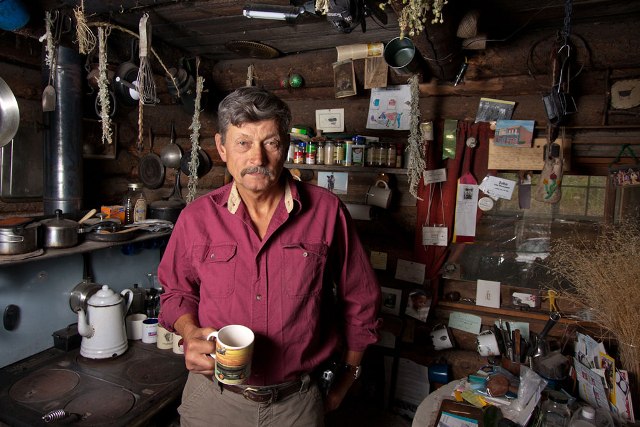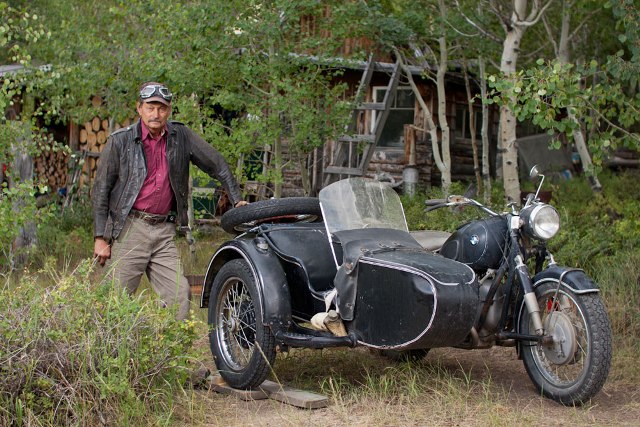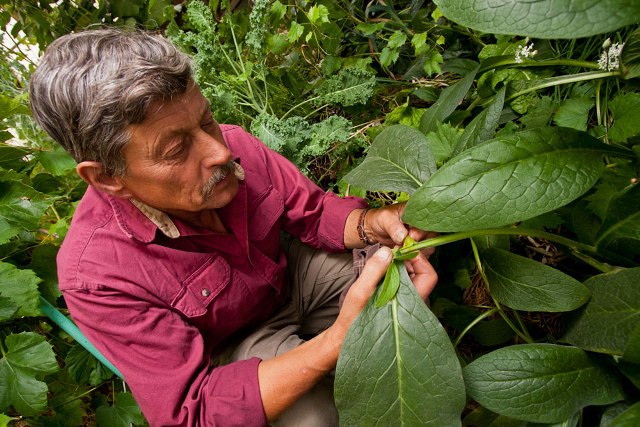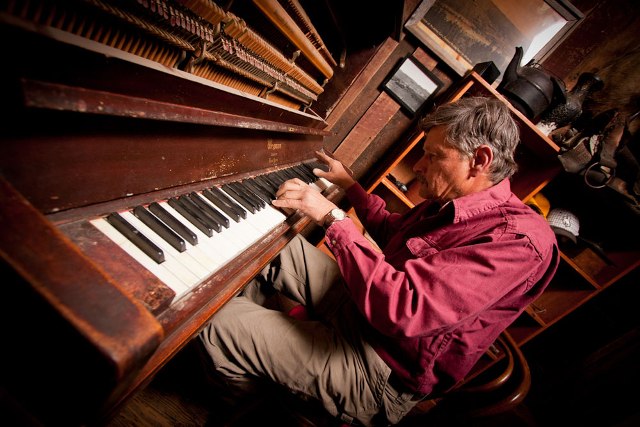Men in Cryptozoology: John Mionczynski
Posted by: Craig Woolheater on October 13th, 2011

One of the two most genuine men I have ever met in Sasquatch research, John Mionczynski, was profiled in this nice article.
Who’s the other you ask? Dr. John Bindernagel of course…
Republished from WyoFile
ATLANTIC CITY, WYO.— In 1972, while camping alone in the Wind River Mountains, the young naturalist John Mionczynski, is convinced that he encountered the creature known as Sasquatch, or “Bigfoot.” Over the decades since, he’s searched for further evidence of a large primate inhabiting the forests of western North America.
In the minds of many, this placed him in that scientific netherworld populated by believers in crop circles, alien invaders and Bermuda triangles. But to cast him off as a paranormal nut would be unfair to one of Wyoming’s most interesting characters who in other spheres has made significant contributions to contemporary understanding of the Wyoming wilderness.

John Mionczynski enjoys a cup of coffee in the cabin he built in the 70’s. (Photo by Brad Christensen)
Mionczynski is self-taught, sometimes eccentric, above all insightful. Pat Hnilicka, a U.S. Fish and Wildlife Service biologist who once worked with him on big horn sheep projects, describes him as a “top-notch” scientist.
“He’s a throwback to old naturalists from many years ago like the Muries,” said Hnilicka, referencing the early 20th-century family who pioneered conservation science based on meticulous field observations of Alaskan caribou, Wyoming elk and other wildlife populations. The Muries pushed for protection of what later became the Alaska National Wildlife Refuge and Grand Teton National Park.
Mionczynski, well-known and well-loved in Lander and Atlantic City, is and has been a pianist and concertina player, motorcyclist, goat packer, researcher of big horn sheep and grizzly bears, desert guide, wilderness survivor and medicinal plants expert. After exploring it for decades, he knows more about the northern Red Desert than perhaps anyone else.
“He’s extremely meticulous and takes great notes. Years later he can look back on notes and draw things out of them,” says Hnilicka.
Mac Blewer, a graduate student in cultural geography at the University of Wyoming, compares Mionczynski to the subject of Blewer’s master’s thesis — Butch Cassidy, the infamous outlaw whom Blewer describes as magnanimous, ever-supportive of his friends while remaining fiercely independent. Like Cassidy, Mionczynski has “a foot planted in this century and in the past as well. His resourcefulness is very rare in this day and age. It’s a pioneer trait. He can talk about anything from mountain man history to the mechanics of the Ford 250 sitting outside.”

John Mionczynski with Serendipity, his custom-built motorcycle pieced together out of parts from four different BMW models from the 1950’s. (Photo by Brad Christensen)
When I met with him recently at his home near Atlantic City, Mionczynski, 64, unfolded two camp chairs in the shade of an aspen grove next to his BMW motorcycle so he could change the oil and repair the broken headlight while we talked. Over thirty years ago, he pieced this motorcycle together out of parts from four different BMWs — a 1951, ’52, ’53 and ’55 — none of which ran. The resulting motorcycle is named Serendipity.
“Whenever I went on a trip with it, it would have some kind of mechanical breakdown and stop me in a place where I had a really significant positive experience, so it had to have that name,” Mionczynski explains.
The motorcycle is small and black, with curving handlebars. It has a sidecar for carrying camping gear or the occasional passenger and gets 50 miles to the gallon, good for the 30-mile trip to Lander, Wyo., where the nearest groceries and gas can be found. His friends have written songs about the motorcycle. Recently, members of a BMW motorcycle backcountry tour group staying at the Miner’s Delight Inn in nearby Atlantic City, Wyo., were impressed when Mionczynski rolled up on Serendipity for his job playing piano. He took the leader of the group, Jim Hyde, for a ride in his sidecar. Hyde hired him to guide future motorcycle tours through the Red Desert for his company RawHyde Adventures.
As we talked, his first Red Desert BMW tour was a week away and the bike needed several repairs including new tires and a new seat spring before it would be ready to go 140 miles over rough roads, so he set to work.
Mionczynski has a hundred projects going at all times, usually involving building or fixing things or figuring out how they work. He lives close to the wild landscape of South Pass and the Red Desert at the southern end of the Wind River Mountains. He barely sets foot inside during the summer, cooking and sleeping on the porches of his cabin, and often spending weeks at a time alone in the mountains or desert. But as soon as he comes home several visitors drop by every day. He’s social, too, frequenting the Mercantile and Miner’s Delight Inn in Atlantic City. He’s never been married; “Not yet,” he says. “But I’m still young.”
From the Atlantic Ocean to Atlantic City
Mionczynski was born in 1947 on the east end of Long Island, New York, a place he describes as woodsy and wild. “You could go out the back door and be in the woods all day and walk to the ocean,” he describes.
From an early age he was interested in science and natural history. His grandfather gave him an entomology book and he memorized the Latin names of all the insects in the book after just one read-through. As a young boy, he had an accident that crushed his elbow. Doctors thought he might not be able to use his left arm again. His mother gave him a small accordion, to help him exercise the elbow. Not only did the squeezebox heal his arm — though it’s still a bit crooked — but it gave rise to a lifelong love of music that’s comforted him and charmed listeners ever since.
Mionczynski went to Southampton College on Long Island where he considered majoring in music, but decided to pursue his love of chemistry instead. However, the higher-level chemistry classes were all calculus, which he didn’t like. He had a minor in marine biology, so switched that to a major and graduated in 1969.
In the meantime, he continued to explore the eastern woods. He was interested in surviving off the land, eating wild plants and figuring out tricks to purify water. Once he got comfortable living this way in the forests around his home he ventured westward to landscapes like the Mojave Desert. In his twenties, in search of a wilder, less-inhabited and more challenging place to live off the land, he pulled out a map of the U.S. and put his finger on the Red Desert of southern Wyoming.
“I like to be alone and that was the greatest place on the planet to be alone at that time,” he explains. The Red Desert spans southern Wyoming from the tip of the Wind Rivers to the Colorado border and from the Green River to the Platte River. It includes high-elevation sagebrush steppe, sand dunes, badlands, and the Great Divide Basin, a harsh, sparse landscape.
Having worked as an apprentice in his brother’s mechanic shop in New York, he carried tools to fix his 1962 Willys Jeep, but when it broke down so badly he could not repair it, he made his way to the nearest town — Atlantic City, population “about 57″ — and found a job playing piano at the Mercantile. He’s lived in that small mining hamlet ever since.
Life at South Pass
The piano job paid him enough to buy another Jeep, this one a ’48, and supported his work prospecting for gold and jade in the desert. Eventually, he bought a few acres of land on the ridge south of town in a spot he liked to hike and camp on hunting trips. He planned to build a house there even though his neighbors warned him he wouldn’t be able to drive to it all winter. He could have built on land closer to town, but preferred the exercise he gets hiking through the snow to his place November through April, which he still does.
In 1973 he had just poured the concrete foundation for his house when a friend who worked at the U.S. Steel mine a few miles away called to tell him they were going to flood a draw that was full of big, straight pines. Mionczynski didn’t have a trailer to haul the timber, so he spent the next two days driving the Jeep three miles over, cutting trees, tying them to the Jeep and dragging them to his home site. He salvaged windows from the dump. The highway department let him take lumber from old snow fences they were tearing down, as long as he cleaned up all the rebar and wire. He used that wood for the floor, loft and roof of the cabin. He found an old wood stove in the dump, too, and refurbished it. In the end, the entire house cost $72. He’s lived there ever since.

John Mionczynski discusses the healing properties of comfrey in his greenhouse. Among the swaths of fruits and vegetables grown there are his strawberries. He picks a bowl for breakfast every day. (Photo by Brad Christensen)
Shortly after building his house, Mionczynski added a greenhouse to his property. Inside the greenhouse grows comfrey used to treat burns, plus green beans, tomatoes, cucumbers, kale, garlic, onions, grapes and strawberries. The strawberries came from a hermit friend of Mionczynski’s named Teddy Hurst who lived on the Sweetwater River in the ‘70s. Hurst was a vegetarian and grew all his own food at 9,000 feet, something Mionczynski admired. Hurst crossed sweet wild strawberries with larger domestic ones, according to Mionczynski. These greenhouse plants — the several-decades-old descendants of Hurst’s — are productive enough that several months of the year he picks a bowl of strawberries every morning.
Mionczynski teaches a daylong field course on wild edible and medicinal plants for Central Wyoming College and occasionally speaks on the subject at the University of Wyoming. Marian Doane, a range technician for the Bureau of Land Management, took the Central Wyoming College course a few times and said, “Sitting around a campfire is best thing to do with John. He’s always bringing over some plant, chewing on a root, making tea. He’s constantly teaching you.”
Mionczynski first got attention in Fremont County playing accordion and piano in an old-time band called the Buffalo Chips. Terry Wehrman, who owned the Atlantic City Mercantile in the early 70s, says as many as 200 people would show up for dances, too many to fit inside the building. Before the Buffalo Chips, people only listened to country rock or country western music, but the band’s Polish bluegrass was a big hit in the area.
Doane, a Lander native, remembers going to the Mercantile in Atlantic City as a teenager to listen. Too young to be allowed into the bar, she’d dance on the porch outside. “You can dance all night, he’s so much fun,” she says. “He’s got a great love for his music.”
Mionczynski built compartments inside of his accordion to carry a first aid kit and some food. He doesn’t like anything to go to waste — even the space inside an instrument — and he appreciates tools that have multiple uses. For example, he devised a system for packing goats into the mountains. The goats provide both transportation of equipment and fresh milk. He’d make yogurt by mixing goat milk and yogurt culture in a jar and wrapping it in a sleeping bag for warmth. He added wild berries for flavor.
In 1982 he started a company called Wind River Pack Goats not only to transport equipment for his backcountry wildlife research but also to haul food and gear for other expeditions such as National Outdoor Leadership School courses. He also rented out pack goats for recreational wilderness trips. In 1992, a Lander publisher printed his book The Pack Goat, which portrays his admiration and respect for the animals and earned him the nickname “the father of goat packing.” For a while he built and sold goat packsaddles. In the late 90s he sold the company to Charlie Wilson of Lander, who still leads pack trips and rents goats in Wyoming and Utah.

John Mionczynski rides Serendipity, his custom-built BMW motorcycle, along his driveway outside of Atlantic City, Wyoming. (Photo by Brad Christensen)
Mionczynski no longer raises goats, but they — along with the motorcycle — are still a defining part of how people know him.
“He’s got a leather helmet, and when you see him coming across the desert on his motorcycle it’s just hilarious,” says Doane, who as an adult led Red Desert tours with Mionczynski. “When he used to raise goats, he’d carry a goat around in the sidecar. The leather helmet and a goat in sidecar — that’s a sight you ought to see. That shows his whole personality. He’s a real character.”
Scientific research
Mionczynski’s curiosity, work ethic and knack for retaining information have served him in his work as a professional wildlife biologist as well. In the early 70s he was hired by the U.S. Forest Service to track radio-collared bighorn sheep. They needed someone who had knowledge of natural history and who could spend time alone in the mountains traveling over difficult terrain without the help of trails. Mionczynski was just this person, and as he relates in his goat packing book, he was very excited about that work.
“These sheep had been fitted with radio collars, and my link to them if they decided to migrate was my receiver,” he wrote. “No one had ever done radio-telemetry studies on bighorn sheep before, so most of what I was doing was experimental.”
He’s continued to follow the plight of the bighorns ever since. In the ’90s when the sheep started to die from mysterious causes, he helped determine part of the cause was air pollution creating acid rain that leached selenium from the soil preventing plants from taking it up, which meant the sheep had selenium deficiency in their diets. In 2007 and 2008, he co-authored three scientific papers on selenium uptake by plants and its presence in the diet of alpine wildlife including sheep and pikas. The U.S. Forest Service acknowledged the importance of his work with an award that hangs on the wall of the loft in his cabin.
In the mid-1970s he also participated in the Interagency Grizzly Bear Study Team, live-trapping grizzlies to affix radio collars to them and then tracking them around Yellowstone.
Mionczynski addresses most issues in his life as an experiment. When packrats mowed down his vegetable garden, he live-trapped a dozen of them and marked each with a spot of paint. Then he released them at increasing distances from his house to see how far he’d have to take one before it wouldn’t return. Released in the next draw, a rat returned to his garden by the end of the day. When he released one a mile away, it came back within a couple days. Two miles away: it showed up three or four days later. He found he had to take a packrat six miles from his place to keep it from returning.
The North American ape
Mionczynski keeps several plaster casts of footprints in one of his storage sheds. They were collected over nearly four decades from around western North America. The largest is about 18 inches long and 8 inches across and looks human, except for the size. Another is smaller, but still enormous, showing splayed toes in great detail. Still another shows where toes slipped in the mud as the heel was lifted.
There is also a huge, if faint, handprint collected from mud underwater in a pond where an animal apparently rested on one hand as it reached out to grasp an aquatic plant with the other. This, he says, matches the silhouette he saw framed in moonlight on the roof of his tent one night many years ago in the Wind River Mountains.
He was camping alone when he awoke to a large hand pressing on the top of his 6-foot-high tent. At first he thought it was a bear, but could distinguish fingers, not a clawed paw. The creature collapsed the tent and fell across Mionczynski’s legs. He scrambled out of the tent as the animal disappeared into the forest nearby. Mionczynski started a fire and stayed awake next to it through the night. He said he could hear the animal breathing and moving nearby for two and a half hours. For 45 minutes it threw pinecones at him, he said, as if it wanted him to leave.
He reported the incident to the Game and Fish Department. Several others also reported sightings in the Wind Rivers that summer, 1972. People were going to the Game and Fish asking for information about the sightings in hopes of finding the creature and shooting it. At first the agency suspected someone in a monkey suit was in danger of getting shot and wanted more information, Mionczynski says, but as things simmered down they dropped the investigation.
For a couple of decades, Mionczynski guarded his interest in the creature he’d encountered that night, even as he continued to look for evidence of its existence. Once, while working for the Wyoming Game and Fish Department, he took a hair and skin sample to the agency’s lab in Laramie for analysis. A superior yelled at him, threatening to have him fired if his name were ever publicly associated with “this Bigfoot thing.”

John Mionczynski plays the piano in the Atlantic City Mercantile. Mionczynski first got attention in Fremont County playing accordion and piano with the Buffalo Chips, a band that played with a Polish bluegrass style. (Photo by Brad Christensen)
Mionczynski says his experience with the research has ranged from, “exciting in a very positive way like you know you’re onto some, as-yet untouched science, to the other extreme of dealing with ridicule and job threats.”
In the late 1990s he met Dr. Jeffrey Meldrum, a primatologist at Idaho State University who specializes in the evolution of bipedalism and had accrued a collection of casts of apparent Bigfoot tracks. The two teamed up and applied for funding to travel around North America interviewing people who’d reported seeing Sasquatches and collecting data and evidence about the sightings. They rated each sighting based on its credibility, and mapped only the most credible cases, which, by their determination, added up to hundreds.
In 2010, National Geographic television did a special on Bigfoot and interviewed Mionczynski. Over the last four years, Mionczynski has worked on this full time, traveling in the summers to assess habitat and potential foods for the creature, set camera traps and try to snare DNA. He reads and writes papers for Wildlife Society and hosts scientific meetings at his cabin during the winters.
Hnilicka, the USFWS biologist, is skeptical about the existence of Bigfoot. But, he says, “At least someone credible like John is trying to do the science and look into it. He’s putting his reputation on the line. I’d give him credit for that.”
In the last couple of years Mionczynski has been diagnosed with emphysema. He can trace his lung problem to a number of things in his past, but he also thinks it has something to do with recent increases in ozone levels in his area. The Wyoming Department of Environmental Quality operates a ground-level ozone monitor near Mionczynski’s house, and he’s found he can predict the ozone levels within ten parts per billion based on how he is feeling — if it’s above 55 ppb he feels terrible and every month or two it gets so bad he has to go on oxygen.
“Then I lose a day’s work and I have to be tied to those tubes,” he says.
In the face of his deteriorating health, Mionczynski’s long-range plan is to leave his cabin in Atlantic City and move to a lower elevation that doesn’t have the ground-level ozone problem. That he believes pollution is driving him away from the blank space on the map, one of the most untrammeled and wildest parts of the country, carries a certain irony. Though if he makes that exodus, it will likely be on the wheels of Serendipity.
— Emilene Ostlind grew up in Big Horn. She earned her degree in creative nonfiction writing and environment and natural resources at the University of Wyoming.
WyoFile is a nonprofit news service focused on Wyoming people, places and policy.
About Craig Woolheater
Co-founder of Cryptomundo in 2005.
I have appeared in or contributed to the following TV programs, documentaries and films:
OLN's Mysterious Encounters: "Caddo Critter", Southern Fried Bigfoot, Travel Channel's Weird Travels: "Bigfoot", History Channel's MonsterQuest: "Swamp Stalker", The Wild Man of the Navidad, Destination America's Monsters and Mysteries in America: Texas Terror - Lake Worth Monster, Animal Planet's Finding Bigfoot: Return to Boggy Creek and Beast of the Bayou.









Having met the guy, talked to him, and driven him around Tyler, TX – all during which I got not inkling one of what a Renaissance man he is – I’d just say this:
If he thinks Bigfoot’s real, you might not want to disagree too readily.
Nice article.
John Mionczynski is, in my opinion, one of the most important people involved sasquatch research. I would love the opportunity to spend time with such an interesting man. By the way, that was a great article. Top notch job Emilene Ostland did!
DWA, would love to hear any insights you gained from your time spent with John! I wonder if John is attending the bigfoot conference in PA next weekend? Anyone else going to that? Meldrum is speaking there.